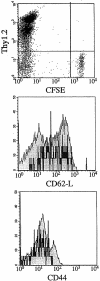DNA vaccination: transfection and activation of dendritic cells as key events for immunity
- PMID: 9874573
- PMCID: PMC1887690
- DOI: 10.1084/jem.189.1.169
DNA vaccination: transfection and activation of dendritic cells as key events for immunity
Abstract
The mechanisms underlying initiation and maintenance of CD4 T cell responses after DNA vaccination were studied using a construct coding for nonsecreted fifth component of complement (C5) protein, thus restricting the availability of antigen. The only cell types to express C5 were keratinocytes at the site of DNA application and a small number of dendritic cells present in the draining lymph nodes. Antigen expression persisted for up to 12 wk in keratinocytes, but dendritic cells did not express C5 beyond 2 wk after vaccination. Cross-priming of dendritic cells by C5 expressed in keratinocytes did not occur unless keratinocyte death was induced by irradiation in vitro. CD4 T cells were activated in the draining lymph nodes only and subsequently migrated to the spleen, where memory T cells persisted for longer than 40 wk despite the absence of a source of persistent antigen. While DNA vaccination resulted in transfection of a small proportion of dendritic cells only, it led to general activation of all dendritic cells, thus providing optimal conditions for effective T cell activation and maintenance of memory.
Figures








Similar articles
-
Mechanisms of tolerance induction in major histocompatibility complex class II-restricted T cells specific for a blood-borne self-antigen.J Exp Med. 1994 Dec 1;180(6):2089-99. doi: 10.1084/jem.180.6.2089. J Exp Med. 1994. PMID: 7964486 Free PMC article.
-
Adjuvants may reduce in vivo transfection levels for DNA vaccination in mice leading to reduced antigen-specific CD8+ T cell responses.Hum Vaccin Immunother. 2015;11(9):2305-11. doi: 10.1080/21645515.2015.1047567. Epub 2015 Jun 19. Hum Vaccin Immunother. 2015. PMID: 26091088 Free PMC article.
-
Enhancement of antigen acquisition by dendritic cells and MHC class II-restricted epitope presentation to CD4+ T cells using VP22 DNA vaccine vectors that promote intercellular spreading following initial transfection.J Leukoc Biol. 2005 Aug;78(2):401-11. doi: 10.1189/jlb.1204722. Epub 2005 Apr 27. J Leukoc Biol. 2005. PMID: 15857936
-
Phenotypic profile of dendritic and T cells in the lymph node of Balb/C mice with breast cancer submitted to dendritic cells immunotherapy.Immunol Lett. 2016 Sep;177:25-37. doi: 10.1016/j.imlet.2016.07.009. Epub 2016 Jul 14. Immunol Lett. 2016. PMID: 27423825
-
Innate immunity in DNA vaccine with Toxoplasma gondii-heat shock protein 70 gene that induces DC activation and Th1 polarization.Vaccine. 2011 Feb 24;29(10):1899-905. doi: 10.1016/j.vaccine.2010.12.118. Epub 2011 Jan 12. Vaccine. 2011. PMID: 21236236
Cited by
-
Epidermal powder immunization induces both cytotoxic T-lymphocyte and antibody responses to protein antigens of influenza and hepatitis B viruses.J Virol. 2001 Dec;75(23):11630-40. doi: 10.1128/JVI.75.23.11630-11640.2001. J Virol. 2001. PMID: 11689645 Free PMC article.
-
Intralymphatic immunization enhances DNA vaccination.Proc Natl Acad Sci U S A. 2001 Mar 13;98(6):3299-303. doi: 10.1073/pnas.051630798. Epub 2001 Feb 27. Proc Natl Acad Sci U S A. 2001. PMID: 11248073 Free PMC article.
-
MUC1 expressing tumor growth was retarded after human mucin 1 (MUC1) plasmid DNA immunization.Int J Immunopathol Pharmacol. 2022 Jan-Dec;36:3946320221112358. doi: 10.1177/03946320221112358. Int J Immunopathol Pharmacol. 2022. Retraction in: Int J Immunopathol Pharmacol. 2025 Jan-Dec;39:3946320241310709. doi: 10.1177/03946320241310709. PMID: 35839304 Free PMC article. Retracted.
-
COVID-19 vaccine platforms: Delivering on a promise?Hum Vaccin Immunother. 2021 Sep 2;17(9):2873-2893. doi: 10.1080/21645515.2021.1911204. Epub 2021 May 25. Hum Vaccin Immunother. 2021. PMID: 34033528 Free PMC article. Review.
-
Induction of immune response in BALB/c mice with a DNA vaccine encoding bacterioferritin or P39 of Brucella spp.Infect Immun. 2001 Oct;69(10):6264-70. doi: 10.1128/IAI.69.10.6264-6270.2001. Infect Immun. 2001. PMID: 11553569 Free PMC article.
References
-
- Donnelly JJ, Ulmer B, Shiver JW, Liu MA. DNA vaccines. Annu Rev Immunol. 1997;15:617–648. - PubMed
-
- Wolff JA, Malone RW, Williams P, Chong W, Acsadi G, Jani A, Felgner PL. Direct gene transfer into mouse muscle in vivo. Science. 1990;247:1465–1468. - PubMed
-
- Condon C, Watkins SC, Celluzzi CM, Thompson K, Falo LD. DNA-based immunization by in vivo transfection of dendritic cells. Nat Med. 1996;2:1122–1128. - PubMed
MeSH terms
Substances
LinkOut - more resources
Full Text Sources
Other Literature Sources
Research Materials
Miscellaneous

